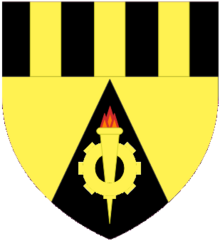 |
The Institute of Measurement and Control (InstMC) is a professional organization for individuals and companies that operate within the measurement and control theory industries. It was founded in 1944 and incorporated by the Royal Charter in 1975.[1] Its objective is to advance the science and practice of measurement and control technologies and their various applications. The institute is both a learned society and a professional qualifying body.[2] InstMC is registered with the Engineering Council and is one of the licensed member institutions allowed to register Chartered Engineers (CEng)[3]
The institute is the UK member body of the International Measurement Confederation (IMEKO)[4] and is the secretariat to the United Kingdom Automatic Control Council (UKACC).
Special Interest Groups
[edit]This Institute currently has a range of Special Interest Groups that organize conferences, seminars and training courses on subjects in the measurement and control fields.
Current Special Interest groups include:
- Cybersecurity
- Measurement
- Functional Safety
- Flow Measurement
- Standards
- Automation and Control
- Digital Transformation
- Systems
Past Presidents
[edit]Notable former presidents of the Institute of Measurement and Control include:
- Sir George Thomson MA FRS (1944–48)
- Sir Harold Hartley GC VO FRS (1957–58)
- L. Finkelstein MSc (1980–81)
- MJH Sterling BEng Phd DEng (1988–89)
- Prof W S Bardo FREng HonFInstMC (2010–12)
- Lord Oxburgh KBE FRS Hon FREng (2012 - 2014)
- Prof Sarah Spurgeon OBE
Affiliations
[edit]- International Measurement Confederation (IMEKO)
- United Kingdom Automatic Control Council (UKACC)
- National Physical Laboratory (NPL)
- Trade Association for Instrumentation, Control, Automation and Laboratory Technology (GAMBICA)
- Worshipful Company of Scientific Instrument Makers (SIM)
- British Standards Institute (BSI)
- Parliamentary and Scientific Committee
See also
[edit]References
[edit]- ^ "THE INSTITUTE OF MEASUREMENT AND CONTROL - Charity 269815". register-of-charities.charitycommission.gov.uk. Retrieved 2023-09-29.
- ^ "THE INSTITUTE OF MEASUREMENT AND CONTROL - Charity 269815". register-of-charities.charitycommission.gov.uk. Retrieved 2023-09-29.
- ^ "Engineering Council". www.engc.org.uk. Archived from the original on 2019-06-17. Retrieved 2018-05-24.
- ^ "Members". www.imeko.org. Archived from the original on 2018-05-25. Retrieved 2018-05-24.
Further reading
[edit]- Engineering Council, UK. ECUK Institution Details Archived 2007-06-08 at the Wayback Machine. Accessed on 13 July 2007
- Institute of Measurement and Control. History and Heritage. Accessed on 13 July 2007
Well, that’s interesting to know that Psilotum nudum are known as whisk ferns. Psilotum nudum is the commoner species of the two. While the P. flaccidum is a rare species and is found in the tropical islands. Both the species are usually epiphytic in habit and grow upon tree ferns. These species may also be terrestrial and grow in humus or in the crevices of the rocks.
View the detailed Guide of Psilotum nudum: Detailed Study Of Psilotum Nudum (Whisk Fern), Classification, Anatomy, Reproduction